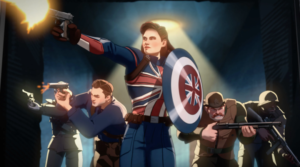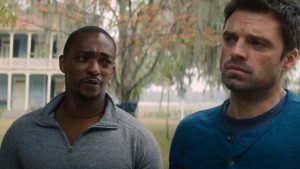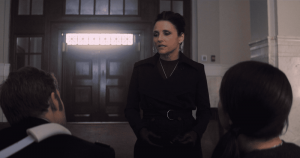SPOILERS FOR WHAT IF…? AHEAD!
If any consistent throughline has emerged in Marvel’s What If…?, it’s that the Ant-Man films are more important than you think. The animated anthology series hasn’t always been kind to the franchise, necessarily – Hank Pym turning into a serial killer and Janet Van Dyne unleashing a zombie virus on the earth could both be considered character regressions – but ironically, these dark twists on what has always been considered the most lighthearted subdivision of the Marvel Cinematic Universe might finally get people to go back and rewatch the Ant-Man films.
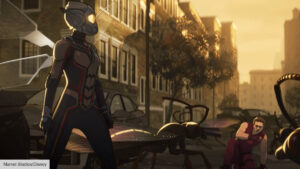
And with Ant-Man And The Wasp: Quantumania shaping up to be an Avengers-level crossover event, that’s a perfectly reasonable ulterior motive for What If…? to have. Now we just have to hope that under Peyton Reed’s usually lackluster direction, Quantumania can handle its core cast of characters as well as What If…? does in only thirty minutes. For me, as a fan of Hope Van Dyne (Evangeline Lilly) especially, I’m gonna be honest: What If…?, more so than either of the Ant-Man films or Endgame, finally gave us the Hope Van Dyne we were promised when she first suited up as the Wasp, and the Hope Van Dyne we deserved.
Being a fan of Hope Van Dyne isn’t easy. Even with so much comics history to draw from in her case, the MCU has never really had a clear idea of what to do with her character or how to realize her full potential – something which the Civil War debacle made very clear. In case you missed it, the Russo Brothers were initially going to work the Wasp reveal into their script for Civil War, including her alongside Scott Lang (Paul Rudd) in the iconic airport battle. And it probably would have been awesome.
But Peyton Reed wasn’t too keen on that idea, because he wanted to introduce the Wasp and define the tone of her action sequences. He got his way, the Russo Brothers relented, and Wasp waited until Ant-Man And The Wasp for her next appearance…which was massively underwhelming, because – surprise, surprise – Peyton Reed is kind of terrible at directing action. And by the time the Russo Brothers finally did get to work with Wasp, they had too many characters on their plate to do anything substantial with her, so she got relegated to a background role in Endgame.
Basically, it’s a mess. But here, in What If…?, Hope Van Dyne is given pride of place in a story that revolves around her, and Lilly proves herself thoroughly up to the task of carrying the episode on her vocal performance. The Nexus Event of this week’s alternate timeline spins out of Ant-Man And The Wasp, with Hope’s mother Janet becoming the host body for a zombie virus that Hope accidentally unleashes upon the world when she brings Janet back from the Quantum Realm (don’t even get me started on Janet’s characterization – or lack thereof – in the MCU thus far). Hope’s grief and guilt drive her to lead the search for a cure, and it’s her brave self-sacrifice that ensures the survival of…well, hope.
This episode is filled with sacrifices, some a little more necessary than others. I was genuinely moved when Bruce Banner (Mark Ruffalo) charged into the zombie horde, going head-to-head with the zombie version of Wanda Maximoff in a fight that actually seemed pretty evenly matched…at least long enough for the remnants of the Avengers to escape Camp Lehigh with a cure for the zombie virus. It was one of the few moments since the very first Avengers movie where Banner’s dignity and heroism have been fully visible. And then on the other hand you have Bucky Barnes (Sebastian Stan) running at Wanda with a tiny pistol and getting catapulted into the stratosphere. The confidence, the total lack of braincells…an all-around himbo, even in death. We stan.
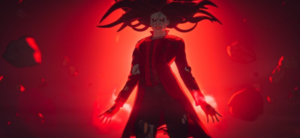
And that’s a big part of what makes What If…? so fun. The stakes are high, and characters die! They also die pretty horribly most of the time, especially in this episode, which is a nice change from how Marvel superheroes usually go, with a few aesthetically-pleasing facial scars and a bruise or two. This adds another layer to the suspense because nobody wants to see their favorite superhero devoured by zombies or worse, transformed into one – although Wanda fans will support her no matter what, and I appreciate that energy (she does cut quite a striking figure as she levitates above the battlefield, her telekinetic abilities still intact but fused with insatiable hunger).
And there’s just something so precious and romantic and not-at-all terrifying about the fact that Vision (Paul Bettany) has been keeping zombie Wanda alive this whole time by feeding her human captives to preserve her strength while working on a cure for her using the Mind Stone embedded in his head. Couple goals, am I right? But of course, there’s no timeline in the Multiverse where Vision doesn’t die tragically, so here he rips the Mind Stone out of his own skull and hands it over to the Avengers as atonement for his actions: which, to be fair, are probably the most villainous that we’ve ever seen from a Marvel hero. Wanda cradles his lifeless body, raising the question of whether zombies can feel emotion, and more importantly, what would a zombie WandaVision look like?
Whether or not Vision’s sacrifice was worth it is left a mystery. The Avengers – or rather, T’Challa (Chadwick Boseman), Peter Parker (voiced by Hudson Thames), Scott Lang’s disembodied head in a glass jar, and Doctor Strange’s levitating cloak – fly off to Wakanda with the Mind Stone and a new sense of purpose, but just before the credits roll it’s revealed that Thanos himself has become a victim of the zombies. Missing only the Mind Stone to complete his Infinity Gauntlet, Thanos sets his sights on Wakanda…and of course, the episode ends there.

What If…? has utilized this type of ending several times now, and assuming the series doesn’t have plans to return to these storylines at some point, I like the idea of offering fans a chance to write their own endings. Every week, this series hands the fanfic authors of the world another opportunity to expand upon the Marvel Multiverse in their own way, and that’s genius. This episode was already full of fanfic tropes, from unexpectedly wonderful crossovers (the payoff to that Baba Yaga gag in Ant-Man And The Wasp…*chef’s kiss*) to a scene of Bucky Barnes showering (although let’s be honest, most fanfics would leave out the Disney-mandated strategically-placed steam).
As of this writing, I am still waiting for that zombie WandaVision AU. Do not make me write this myself.
Episode Rating: 8.9/10
